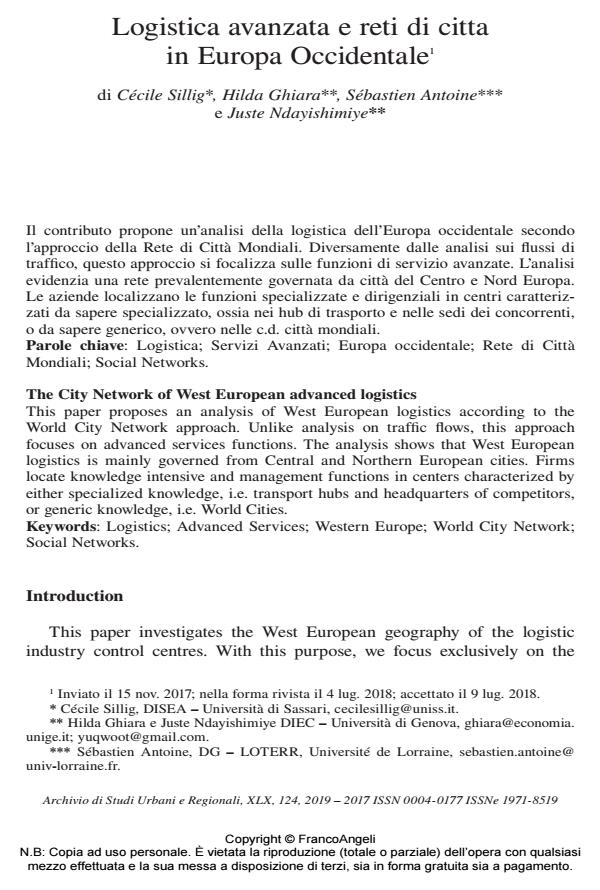Logistica avanzata e reti di citta in Europa Occidentale
Titolo Rivista ARCHIVIO DI STUDI URBANI E REGIONALI
Autori/Curatori Cécile Sillig, Hilda Ghiara, Sébastien Antoine, Juste Ndayishimiye
Anno di pubblicazione 2019 Fascicolo 2019/124 Lingua Italiano
Numero pagine 26 P. 96-121 Dimensione file 185 KB
DOI 10.3280/ASUR2019-124005
Il DOI è il codice a barre della proprietà intellettuale: per saperne di più
clicca qui
Qui sotto puoi vedere in anteprima la prima pagina di questo articolo.
Se questo articolo ti interessa, lo puoi acquistare (e scaricare in formato pdf) seguendo le facili indicazioni per acquistare il download credit. Acquista Download Credits per scaricare questo Articolo in formato PDF

FrancoAngeli è membro della Publishers International Linking Association, Inc (PILA)associazione indipendente e non profit per facilitare (attraverso i servizi tecnologici implementati da CrossRef.org) l’accesso degli studiosi ai contenuti digitali nelle pubblicazioni professionali e scientifiche
Il contributo propone un’analisi della logistica dell’Europa occidentale secondol’approccio della Rete di Citta Mondiali. Diversamente dalle analisi sui flussi ditraffico, questo approccio si focalizza sulle funzioni di servizio avanzate. L’analisievidenzia una rete prevalentemente governata da citta del Centro e Nord Europa.Le aziende localizzano le funzioni specializzate e dirigenziali in centri caratterizzatida sapere specializzato, ossia nei hub di trasporto e nelle sedi dei concorrenti,o da sapere generico, ovvero nelle c.d. citta mondiali.;
Keywords:Logistica; Servizi Avanzati; Europa occidentale; Rete di CittaMondiali; Social Networks.
- Armstrong and Associated (2013). 2013 Top 50 Global and Domestic U.S. Third-Party Logistics Providers. -- Available at: www.supplychain247.com/article/2013_top_50_global_top_30_domestic_3pls (last access 25 October 2017).
- Antoine S., Sillig C. and Ghiara H. (2016). Advanced Logistics in Italy: A City Network Analysis. Tijdschrift voor Economische en Sociale Geografie.
- Beaverstock J.V., Smith R.G. and Taylor P.J. (1999). A roster of World Cities. Cities, 16(6): 445-458. DOI: 10.1016/S0264-2751(99)00042
- Baeverstock J.V., Doel M.A., Hubbard P.J. and Taylor P.J (2002). Attending to the world: competition, cooperation and connectivity in the World City network. Global Network, 2(2): 111-132. DOI: 10.1111/1471-0374.0003
- Castells M. (1996). The Rise of the Network Society. Oxford: Blackwell.
- Dallari F. e Curi S. (2010) Network Milano. Morfologia dei flussi logistici internazionali. Milano: Bruon Mondadori.
- Ducruet C., Ietri D. and Rozenblat C. (2011). Cities in Worldwide Air and Sea Flows: A multiple networks analysis. Cybergeo: European Journal of Geography.
- Friedmann J. (1986). The world city hypothesis. Development and Change, 17: 69-83.
- Frobel F., Heinrichs J. and Kreye O. (1980). The New International Division of Labour. Cambridge: Cambridge University Press.
- Ghiara H. e Sillig C. (2007), Il cluster logistico-portuale genovese. In: Musso E. e Ghiara H., a cura di, Ancorare i porti al territorio: dai traffici alla marittimizzazione. Milano: McGraw-Hill.
- Graham L. and Sahling L. (2004). European Warehouse Market Research. Overview of Pan European Trends. Amsterdam: Prologis.
- Guerrero D. and Proulhac L. (2014). Freight flows and urban hierarchy. Research in Transportation Business and Management, 11: 105-115.
- Hesse M. (2008). The city as a terminal: the urban context of logistics and freight transport. Burlington: Ashgate.
- Hesse M. and Rodrigue J.-P. (2004). The transport geography of logistics and freight distribution. Journal of Transport geography, 12: 171-184.
- Hesse M. and Rodrigue J.-P. (2006). Global Production Networks and the Role of Logistics and Transportation. Growth and Change, 37(4): 499-509.
- Jacobs W., Ducruet C. and De Langen P. (2010). Integrating world cities into production networks: the case of port cities. Global Networks, 10(1): 92-113.
- Jacobs W., Koster H. and Hall P. (2011). The Location and Global Network Structure of Maritime Advanced Producer Services. Urban Studies, 48(13): 2749-2769. DOI: 10.1177/004209801039129
- Musso E. e Ghiara H. (2007) (a cura di). Ancorare i porti al territorio: dai traffici alla marittimizzazione. Milano: McGraw-Hill.
- Norall S. (2013). 3PL vs 4PL: What are these PLs anyway? Layers of logistics explaines. -- Available at: http://cerasis.com/2013/08/08/3pl-vs-4pl/ (last access 25 October 2017).
- O’Connor K. (2010). Global City regions and the location of logistics activity. Journal of Transport Geography, 18(3): 354-362.
- O’Connor K., Holly B. and Clarke A. (2012). A case for incorporating logistics services in urban and regional policy: some insights from US metropolitan areas. Regional Science Policy and Practice, 4(2): 165-177.
- O’Connor K., Derudder B. and Witlox F. (2016). Logistics Services: Global functions and global cities. Growth and Change, 47(4): 481-496.
- Perulli P. (2012) (a cura di). Nord. Una citta-regione globale. Bologna: il Mulino.
- Saglietto L. (2013). Toward a classification of fourth party logistics (4PL). Universal Journal of Industrial and Business Management, 1(3): 104-116.
- Sassen S. (1993). The Global City. Princeton: Princeton University Press.
- Sassen S. (2000). Cities in a World Economy. Thousand Oaks: Pine Forge.
- Taylor P.J. (2001). Specification of the World City Network. Geographical Analysis, 33 (2): 181-194.
- Taylor P.J. (2004). World city network: a global urban analysis. London-New York: Routledge.
- Taylor P.J., Hoyler M., Walker D.R.F. and Szegner M.J. (2001). A new mapping for the new millennium. The Geographical Journal, 167(3): 213-222. DOI: 10.1111/1475-4959.0001
- Taylor P.J., Catalano G. and Walker D.R.F. (2002). Measurement of the World City Network. Urban Studies, 39(13): 2367-2376. DOI: 10.1080/0042098022008001
- Thrift N.J. (1996). Spatial Formations. London: Sage.
- Thrift N.J. (1997). Cities without modernity, cities with magic. Scottish Geographical Magazine, 113(2): 138-149. DOI: 10.1080/0036922971873700
- Verhetsel A. and Sel S. (2009). World maritime cities: From which cities do container shipping companies make decisions? Transport Policy, 16(5): 240-50.
- Wang J. and Cheng M.C. (2010). From a hub port city to a global supply chain management center: a case study of Hong Kong. Journal of Transport Geography, 18: 104-115.
- Adapter le world city network à la mesure de l’économie régionale. L’exemple du secteur de la logistique en Italie Sébastien Antoine, Cécile Sillig, Hilda Ghiara, Pierre Ginet, in Annales de géographie /2020 pp.81
DOI: 10.3917/ag.735.0081
Cécile Sillig, Hilda Ghiara, Sébastien Antoine, Juste Ndayishimiye, Logistica avanzata e reti di citta in Europa Occidentale in "ARCHIVIO DI STUDI URBANI E REGIONALI" 124/2019, pp 96-121, DOI: 10.3280/ASUR2019-124005